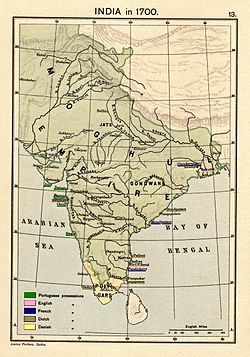| Revision as of 07:58, 27 December 2024 edit117.194.140.46 (talk) The Far Southern states of India and its Northeast were never under mughal or any other muslims' rule. This fanciful claim was sneaked in here by one of the socks of indeffed user tubergottubed. All his socks have been indeffed since but many of his falsities and lies remain here.← Previous edit | Revision as of 15:47, 28 December 2024 edit undoAirshipJungleman29 (talk | contribs)Extended confirmed users, Page movers, New page reviewers, Pending changes reviewers, Rollbackers, Template editors44,511 edits Requesting speedy deletion (CSD G5).Tags: Twinkle RevertedNext edit → | ||
| Line 1: | Line 1: | ||
| {{db-banned|user=JingJongPascal}} | |||
| {{Not to be confused with|Emperor of India}} | {{Not to be confused with|Emperor of India}} | ||
| {{use dmy dates|date=December 2024}} | {{use dmy dates|date=December 2024}} | ||
Revision as of 15:47, 28 December 2024
| This article may meet Misplaced Pages's criteria for speedy deletion as a page created by a banned or blocked user (JingJongPascal) in violation of the user's ban or block, with no substantial edits by others. See CSD G5.%5B%5BWP%3ACSD%23G5%7CG5%5D%5D%3A+Created+by+a+%5B%5BWP%3ABAN%7Cbanned%5D%5D+or+%5B%5BWP%3ABLOCK%7Cblocked%5D%5D+user+%28%5B%5BUser%3AJingJongPascal%7CJingJongPascal%5D%5D%29+in+violation+of+ban+or+blockG5
If this article does not meet the criteria for speedy deletion, or you intend to fix it, please remove this notice, but do not remove this notice from pages that you have created yourself. If you created this page and you disagree with the given reason for deletion, you can click the button below and leave a message explaining why you believe it should not be deleted. You can also visit the talk page to check if you have received a response to your message. Note that this article may be deleted at any time if it unquestionably meets the speedy deletion criteria, or if an explanation posted to the talk page is found to be insufficient. Note to administrators: this article has content on its talk page which should be checked before deletion. This criterion doesn't apply to templates which are transcluded by other pages, unless these transclusions were all done by the banned user in question.Administrators: check links, talk, history (last), and logs before deletion. Consider checking Google. This page was last edited by AirshipJungleman29 (contribs | logs) at 15:47, 28 December 2024 (UTC) (17 days ago) |

Emperor of Hindustan sometimes also translated as Emperor of India was an imperial title used by the Delhi Sultanate and the Mughal Empire to signify their sovereignity over Northern India and later much of the Indian subcontinent (excepting the Far-Southern states of present-day India and its Northeastern parts as well).

The term was simultaneously used for Northern India and the Indian subcontinent during the Medieval period. During the rule of the Mughal Empire in the 16th century, the term was equivalent to Emperor of India.
Even after Mughal rule had collapsed, by about 1720, the other powers in India, such as the Maratha Confederacy, the British East India Company and many others, continued to use the title in certain contexts until the Mughal Empire was formally abolished in 1858. For example, the East India Company issued coinage in the name of the "emperor", and bearing this title, until then. Part of the reason for this was to avoid other powers claiming the title, during the prolonged struggle for supremacy in India.
History
Delhi Sultanate
After the Delhi Sultanate gained independence from the Ghurid Empire, it called its land Hindustan, representing its sovereignity over Northern India (Punjab and the Indo-Gangetic plains) and later the Indian subcontinent.

Scholar Bratindra Nath Mukherjee states that during the Delhi Sultanate, Hindustan simultaneously represented Northern India as well as the entire Indian subcontinent.
Mughal Empire
The Delhi Sultanate was succeeded by the Mughal Empire, which called its polity Hindustan. By this period, Hindustan had come to mean the entirety of the Indian subcontinent rather than only Northern India.

Variations
The title Emperor of India was also used for the Mughal emperors in some translated sources, a term later used by British monarchs.
Other variations were also used:
Sultan of Al-Hind (Salṭan-i-al-Hindīyyah)
Sultanate of Hindustan (Salṭan-i-Hindūstan)
See also
- Hindustan
- List of sultans of Delhi
- List of emperors of the Mughal Empire
- Monarchs of India
- Emperor of India
References and notes
- Only during the period of the Mughal Empire during and after the 16th century.
- Larned, Josephus Nelson (1895). History for Ready Reference: From the Best Historians, Biographers, and Specialists; Their Own Words in a Complete System of History ... C.A. Nichols Company.
- Hindustan), Jahangir (Emperor of (1999). The Jahangirnama: Memoirs of Jahangir, Emperor of India. Freer Gallery of Art, Arthur M. Sackler Gallery. ISBN 978-0-19-512718-8.
- Journal of Historical Research. Department of History, Ranchi University. 1983.
- Jackson, Peter (16 October 2003). The Delhi Sultanate: A Political and Military History. Cambridge University Press. p. 86. ISBN 978-0-521-54329-3.
- Mukherjee, Bratindra Nath (1989). The Foreign Names of the Indian Subcontinent. Place Names Society of India.
- Vanina, Evgenii͡a I͡Urʹevna (2012). Medieval Indian Mindscapes: Space, Time, Society, Man. Primus Books. ISBN 978-93-80607-19-1.